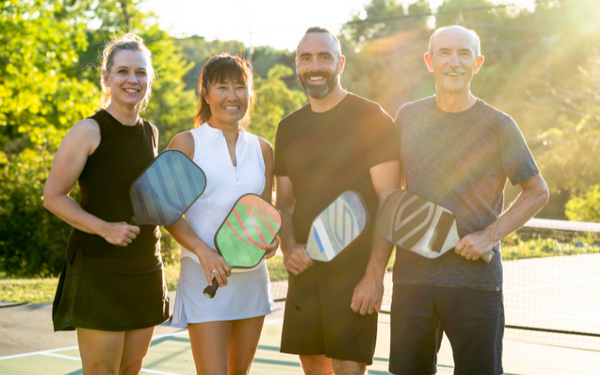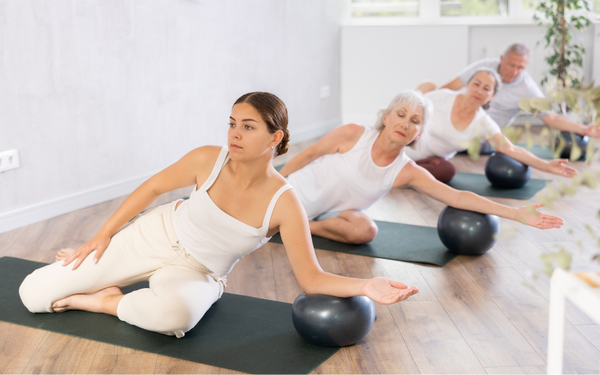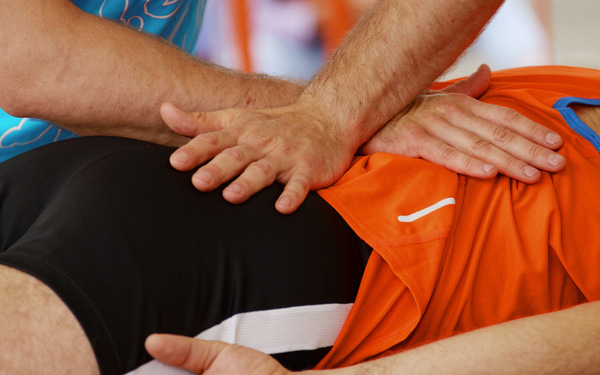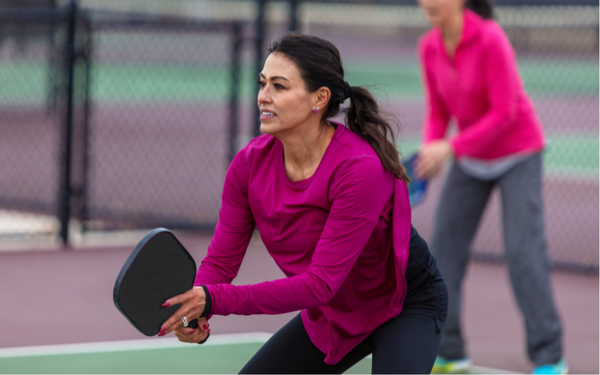No Products in the Cart
Cross-training, the practice of engaging in various types of exercises outside of one’s primary sport, is pivotal for pickleball enthusiasts looking to elevate their game.
By incorporating different activities into your training regimen, you can improve your physical fitness, agility, strength, and even mental toughness, all of which are crucial components of a stellar pickleball player. This blog post will delve into a curated list of cross-training activities specially tailored for pickleball players, aiming to complement and enhance your prowess on the court. From boosting cardiovascular health to strengthening muscle groups most utilized in the game, and even sharpening your strategic thinking, we’ve got you covered.
Let’s dive into how you can become a more formidable player by integrating these cross-training activities into your routine.
Cross-training stands as a cornerstone for athletes aiming to achieve a well-rounded fitness level, and it holds particular significance for pickleball players. At its core, cross-training involves engaging in a variety of physical activities outside of your primary sport. This approach not only combats the monotony of repetitive training routines but also mitigates the risk of overuse injuries, which are common among sports enthusiasts who repeatedly engage in the same movements.
For pickleball players, cross-training is not just about physical diversification; it's about honing the specific skills and physical attributes that the sport demands. Pickleball requires a unique blend of agility, endurance, strength, and strategic thinking.
A well-designed cross-training regimen can help address and develop these areas by:
Incorporating a variety of exercises that focus on these aspects can not only improve your overall fitness but also translate into marked improvements on the pickleball court. Whether you're a beginner looking to climb the ranks or an experienced player aiming to maintain your edge, cross-training offers a pathway to achieving your goals.

A strong cardiovascular system is the engine behind sustained, high-level performance in any sport, and pickleball is no exception. Enhancing your cardiovascular fitness can significantly improve your stamina, allowing you to stay energetic and sharp throughout long matches or tournaments. Here are some effective cardiovascular activities that complement pickleball training:
Incorporating running or jogging into your fitness routine is a straightforward and effective way to build endurance. These activities mimic the continuous movement of pickleball, preparing your body to withstand the demands of extended play. Even short, consistent runs can lead to substantial improvements in your ability to recover quickly between points.
Cycling stands out as a superb low-impact alternative to running, offering substantial cardiovascular benefits without the same level of stress on your joints. It's particularly beneficial for building leg strength and endurance, which are essential for maintaining an active presence on the pickleball court. Regular cycling sessions can help you develop the stamina to keep your legs moving quickly and efficiently, even in the later stages of a game.
Swimming is an excellent way to enhance cardiovascular health while also providing a full-body workout. It's particularly beneficial for pickleball players looking for a non-weight-bearing exercise option that reduces the risk of injury. The resistance of the water provides a unique challenge for your muscles, helping improve endurance and strength. Additionally, swimming is a great way to cool down and recover on rest days, offering a gentle way to loosen up muscles that might be tight from pickleball play.
Each of these cardiovascular activities offers unique benefits, but they all contribute to a common goal: building the endurance needed to perform at your best in pickleball. By integrating these exercises into your training regimen, you can ensure that your heart and lungs are as prepared for competition as your paddle skills.

Strength training is a critical component of a comprehensive cross-training program for pickleball players. It not only enhances muscle power and endurance but also plays a crucial role in injury prevention. By focusing on the key muscle groups used in pickleball, you can develop a stronger, more resilient body capable of executing powerful shots and sustaining longer rallies. Here’s how to incorporate strength training into your pickleball cross-training regimen:
Resistance training, which includes the use of free weights, resistance bands, or bodyweight exercises, can significantly improve your power, stability, and balance on the pickleball court. Focus on exercises that strengthen the core, legs, and arms—areas heavily relied upon in pickleball. For example, squats and lunges enhance leg strength for improved lateral movements and sprints, while shoulder presses and rows build arm and shoulder strength for more powerful serves and smashes.
Plyometric exercises are designed to improve explosive power, a critical asset for quick starts, stops, and changes in direction during a pickleball game. Incorporating jumps, bounds, and hops into your training regimen can boost your agility and speed, enabling you to reach shots faster and with more stability. Plyometrics also enhance your ability to generate power from the lower body, contributing to stronger and more effective strokes.
While not often associated with strength in the traditional sense, yoga and Pilates are excellent for building core strength, flexibility, and balance—all of which are vital for pickleball players. These practices focus on controlled movements and body alignment, enhancing muscle tone and endurance without adding bulk. Additionally, the emphasis on core stability and posture can help reduce the risk of injuries and improve your efficiency on the court by allowing for more precise and controlled movements.
Incorporating a mix of resistance training, plyometrics, and flexibility-focused exercises like yoga and Pilates can create a well-rounded strength training program that addresses the needs of pickleball players. Not only will these activities improve your physical performance, but they will also contribute to your overall health and well-being, enabling you to enjoy the game for years to come.

In addition to physical conditioning, pickleball players can benefit greatly from activities that sharpen their skills, particularly those that enhance hand-eye coordination, strategic thinking, and quick reflexes. Engaging in other racket sports or specific drills can provide valuable cross-training benefits that translate directly to improved performance on the pickleball court.
Both tennis and badminton share similarities with pickleball in terms of skills and strategies, making them excellent cross-training sports. Playing tennis can improve your power and endurance, as it typically involves a larger court and longer rallies. Badminton, on the other hand, enhances your speed, agility, and wrist strength due to the fast-paced nature of the game and the lighter racket and shuttlecock. Engaging in these sports can also refine your shot placement and strategic play, skills that are directly transferable to pickleball.
Table tennis might seem like a less physically demanding sport, but it's excellent for improving hand-eye coordination and reflexes. The rapid exchanges require precise timing and quick reactions, training your body and mind to respond swiftly and accurately. These attributes are crucial in pickleball, especially when facing fast volleys at the net.
Squash is another racket sport that can complement your pickleball training by enhancing your agility, quick directional changes, and aerobic conditioning. The high-intensity nature of squash, with its quick points and dynamic movements, can help pickleball players improve their cardiovascular fitness, reaction time, and strategic thinking.
Incorporating these skill-based sports and drills into your training regimen can provide a fun and effective way to develop the specific skills required for pickleball. Not only do they help keep your workouts varied and interesting, but they also allow you to practice and improve upon the fundamental techniques and strategies used in pickleball.

The mental aspect of pickleball is just as crucial as the physical. A sharp mind can be the difference between a good player and a great one. Mental and tactical training helps players maintain focus, make quick decisions under pressure, and stay mentally resilient during challenging matches. Here's how you can incorporate mental and tactical training into your pickleball regimen:
Meditation can significantly enhance concentration, reduce stress, and improve overall mental well-being, contributing to better performance on the court. Regular meditation practice helps in maintaining focus and composure, even in high-pressure situations. Visualization, a technique often used in conjunction with meditation, involves mentally rehearsing game scenarios, shots, and strategies. This practice can improve your ability to anticipate and react during actual play, making your responses more instinctive and effective.
Engaging in strategy games such as chess, Go, or even certain video games can sharpen your tactical thinking and decision-making skills. These games require foresight, planning, and the ability to anticipate opponents' moves, similar to strategizing in pickleball. Regularly playing strategy games can help you develop a deeper understanding of tactical play, improve your problem-solving skills, and enhance your ability to make quick, strategic decisions during matches.
Practicing mindfulness can help you stay present during games, reducing anxiety and improving performance. Mental toughness exercises, such as setting small, achievable goals or practicing positive self-talk, can build resilience, helping you to bounce back from setbacks more effectively. These practices teach you to maintain a positive and focused mindset, crucial for competing at your best.
Incorporating mental and tactical training into your routine is essential for developing a well-rounded approach to pickleball. By improving your mental game, you can gain a competitive edge, making you a more formidable and strategic player on the court.

Recovery and injury prevention are pivotal aspects of any training regimen, especially for pickleball players who engage in repetitive motions and quick, explosive movements. Proper recovery practices not only aid in preventing injuries but also ensure that you can train consistently and perform at your best. Here are essential recovery and injury prevention strategies to incorporate into your pickleball cross-training plan:
Regular stretching before and after playing pickleball can significantly improve flexibility and reduce the risk of muscle strains. Incorporating dynamic stretches during warm-ups prepares your body for the activity ahead, while static stretching during cool-downs helps to elongate the muscles and reduce post-exercise soreness. Foam rolling, another beneficial practice, can help alleviate muscle tightness and improve blood circulation, speeding up the recovery process and reducing the risk of injury.
Sports massage is an effective tool for injury prevention and recovery. It not only helps in relaxing and stretching muscles but also improves blood flow, which aids in the healing process. Regular sports massages can help break down scar tissue, reduce stiffness, and increase range of motion, making them an invaluable addition to your recovery routine.
Adequate rest is crucial for the body to repair and strengthen itself. Ensuring you get enough sleep and incorporating rest days into your training schedule can prevent overtraining and reduce the risk of injury. Nutrition also plays a vital role in recovery; consuming a balanced diet rich in proteins, healthy fats, carbohydrates, and micronutrients supports muscle repair and energy replenishment. Staying hydrated is equally important, as dehydration can impair performance and increase the risk of cramps and injuries.
Integrating these recovery and injury prevention strategies into your training regimen is essential for maintaining long-term health and ensuring you can continue enjoying pickleball for years to come. By giving your body the care it needs, you can stay active, reduce downtime due to injuries, and perform at your peak.

Having explored the diverse components of an effective cross-training regimen for pickleball, the final step is to integrate these elements into a cohesive, balanced training plan. A well-structured cross-training plan ensures you're developing all the necessary skills and attributes—physical, mental, and tactical—while also prioritizing recovery and injury prevention. Here are some tips for creating and implementing a successful cross-training schedule:
Define what you aim to achieve with your cross-training. Goals can range from improving specific physical attributes like endurance or strength, enhancing your mental game, or simply reducing the risk of injury. Having clear objectives will help you tailor your cross-training activities to meet your needs.
Your cross-training schedule should include a mix of cardiovascular exercises, strength training, skill-based drills, mental training, and recovery practices. Balance is key; ensure you're not overemphasizing one area at the expense of others. For example, you might dedicate certain days to cardiovascular and strength training, intersperse skill-based sports or drills on alternate days, and incorporate mental training and recovery techniques throughout the week.
While it's important to push yourself, listening to your body is crucial to prevent overtraining and injuries. If you're feeling particularly fatigued or sore, allow yourself extra rest or focus on recovery techniques such as stretching, foam rolling, or yoga. Adjust your training plan based on how your body responds to ensure you're progressing safely.
Variety not only keeps your training interesting but also challenges your body in new ways, promoting continued improvement. Try different activities for cardiovascular fitness, experiment with new strength exercises, and play other racket sports to keep your training engaging and comprehensive.
Ensure your cross-training activities complement your pickleball practice sessions. For instance, if you're working on improving your agility on the court, focus on plyometric exercises that enhance quick, explosive movements. Similarly, if you're looking to improve your mental toughness during matches, increase your focus on meditation and visualization techniques.
Regularly evaluate your progress towards your goals and adjust your training plan as needed. This might involve increasing the intensity of your workouts, introducing new exercises, or focusing more on recovery if you're experiencing fatigue or soreness. Flexibility in your approach will allow you to continuously adapt and optimize your training for the best results.
Implementing a comprehensive cross-training plan is a dynamic process that requires ongoing assessment and adjustment. By systematically integrating the various components of cross-training into your routine, you can enhance your overall performance in pickleball, reduce the risk of injury, and enjoy a healthier, more balanced approach to your sport.

Cross-training is a powerful tool for enhancing your pickleball game, offering benefits that extend from physical improvements to mental sharpness. By diversifying your training with activities that boost endurance, strength, agility, and strategic thinking, you're not just preparing to meet the demands of pickleball—you're setting yourself up for a more enjoyable and successful experience in the sport.
Remember, the key to a successful cross-training regimen is balance and consistency. Listen to your body, mix up your routines to keep things interesting, and focus on your overall health and well-being. As you integrate these practices, you'll likely see noticeable improvements in your game and your enjoyment of it.
We encourage you to share your own cross-training tips and experiences. Your journey could inspire others to explore new ways to enhance their game. Keep pushing your limits, and enjoy every moment on the court!
Check out Born to Rally blog to read more interesting pickleball-related articles.